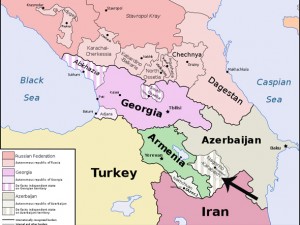The scope of conflict in Nagorno-Karabakh
South Caucasus is a historical region between Russia, Iran and Turkey shared by Azerbaijanis, Armenians and Georgians. Situated in its center Nagorno-Karabakh remained for a long time a unique example of common peaceful co-existence of several ethnics that do not have the same language, religion and views of common history, but lots of common cultural artifacts instead. Material and unmaterial things that were created by ethnosis or nation during its development. E.g for ancien Egyptians its papyruses, for Chinese people – porceilan, greeks – pottery. coins, but also poetry and literature as unmaterial items, for turks – carpets, etc. Specifically in Karabakh there were lots of this things (inc. pottery, carpets, poems ) that were created by significant influences from both armenians and azerbaijanis.
In the beginning of the 20th century the concept of regional multiculturalism met the raise of nationalism hastened by massacres and deportations of Armenians in neighbor Ottoman Empire. The treaty of Kars (1921) postponed the national tensions putting the whole South Caucasus (except several areas given to new born Turkey) under the Soviet Union dominance; Nagorno-Karabakh therefore was approved in territory of Soviet Azerbaijan Republic.
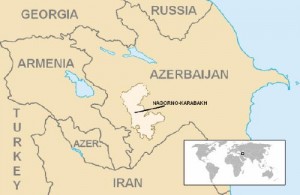 The multicultural region clashed in the end of 80s, during the disintegration of the USSR. The majority of Armenians in the Nagorno-Karabakh region claimed the rigth of self-determination as they opposed living under the Azerbaijani rule that they considered to be unfair. Pogroms (ed: plunderings/ violent attacks) of Armenians in Sungari and Baki accelerated the sad result – the Karabakh war started. From that moment a diverse land populated either by Azerbaijanis and Armenians met terrible examples of national conflicts: tensions of discrimination by nationalities, deportations, massacres of peasants in Maragi and in Khojaly. Azerbaijan´s population has left the region living now in IDP-camps of Azerbaijan as internally displaced persons. The whole Nagorno-Karabakh region and the surrounding areas were “occupied” (Azerbaijan point of view), “freed” (Armenian point of view).
The multicultural region clashed in the end of 80s, during the disintegration of the USSR. The majority of Armenians in the Nagorno-Karabakh region claimed the rigth of self-determination as they opposed living under the Azerbaijani rule that they considered to be unfair. Pogroms (ed: plunderings/ violent attacks) of Armenians in Sungari and Baki accelerated the sad result – the Karabakh war started. From that moment a diverse land populated either by Azerbaijanis and Armenians met terrible examples of national conflicts: tensions of discrimination by nationalities, deportations, massacres of peasants in Maragi and in Khojaly. Azerbaijan´s population has left the region living now in IDP-camps of Azerbaijan as internally displaced persons. The whole Nagorno-Karabakh region and the surrounding areas were “occupied” (Azerbaijan point of view), “freed” (Armenian point of view).
Till now the tensions remain. The war was frozen in 1994, both sides stand on their positions and moreover the conflict is now often used for political reason to distract the view from ones local problems. National media is used to manipulate the view of locals and to amplify the hate, youth from both sides can’t meet each other except outside their home lands.
The Scope of conflict resolution meeting
The task of building the civil society for Caucasus starts from creating the common history that is impossible without oral histories exchange. Common values, power of personalities, seminars, trainings and workshops, non-formal Education – are effective measures help to deal with long term-conflict on youth level and facilitate the peace building process between two countries. Examples like the co-operation between young people from different cultures and backgrounds in this event are the best proof that it is not only possible but it could be quickly realized for active youth: to live in peace and co-operation in a more and more interconnected world.
In order to create a common base of communication, understanding and ensuring support from the authorities for our Students´ Forum and the locals in Caucasus, President Luis Alvarado Martinez, Projects Director Miguel Gallardo Albajar and Liaison Officer towards OSCE Alin-Florin Calin attended the Conflict Resolution Meeting as AEGEE-Europe’s representatives and took the opportunity to meet with the Ministry of Youth and Sports of Azerbaijan, the Azerbaijan Youth Foundation and Azerbaijan’s Youth Council (NAYORA). Future collaboration for new projects on conflict resolution was discussed, with a special focus on the situation of the region Nagorno-Karabakh.
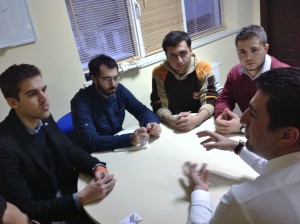
Subsequently the Conflict Resolution Meeting, organized by AEGEE- Bakı, was officially opened from 7th to 11th of February in Baku. It united more than 30 young peacemakers from Europe, Caucasus and Middle East: from the Netherlands to Turkey or from Finland to Pakistan who met and discussed conflict resolution issues and presented their experiences. The participants enjoyed watching the traditional “1001 night” ballet at Baku Opera and Ballet Theater and the adventurous spirit of six hours travelling by minivan to the second largest city of Azerbaijan and runner for European Youth Capital 2016 – Ganja. The group met there with local NGOs and youth.
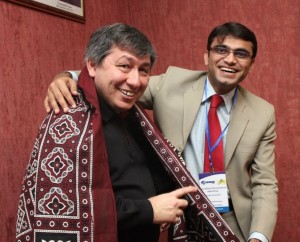
A big part of agenda took the topic about the conflict in Caucasus between Armenia and Azerbaijan. Experts from the Baku State University Dr. Altay Goyushov (PhD) and Mr. Azad Garibli (MSc) gave a historical insight into history of Azerbaijan and demonstrated the external influences in the region during the development of Azerbaijani nation that caused the current state of things. The influence of Russia especially was enlightened while discussing the situation in rebel regions of Ossetia and Abkhazia of Georgia. The speakers underlined the necessity of regional identity and common history for the peaceful and economically profitable future.
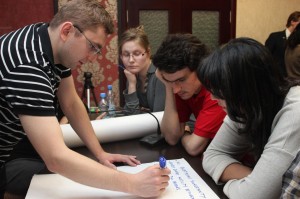 “There is a necessity of media regulation umbrella over the conflict zones” – told the author of the second workshop devoted to nationalistic media influence esp. on youth in conflict regions. His well accented necessity of bringing the people together in European mediation projects correspond well with AEGEE-strategy positioning youth as a stakeholder in conflicts. As one of the examples an author presented an AEGEE peace building project in Caucasus “Musicians without borders”, applied recently to several European foundations. Groups for each regional conflict worked on potential solutions to improve the situation in conflicts Nagorno-Karabakh, Georgia – Abkhazia – Ossetia and Israel-Palestine in order to find a way out from the conflicts. They gave a short introduction into the conflict they were discussing and their conclusions.
“There is a necessity of media regulation umbrella over the conflict zones” – told the author of the second workshop devoted to nationalistic media influence esp. on youth in conflict regions. His well accented necessity of bringing the people together in European mediation projects correspond well with AEGEE-strategy positioning youth as a stakeholder in conflicts. As one of the examples an author presented an AEGEE peace building project in Caucasus “Musicians without borders”, applied recently to several European foundations. Groups for each regional conflict worked on potential solutions to improve the situation in conflicts Nagorno-Karabakh, Georgia – Abkhazia – Ossetia and Israel-Palestine in order to find a way out from the conflicts. They gave a short introduction into the conflict they were discussing and their conclusions.
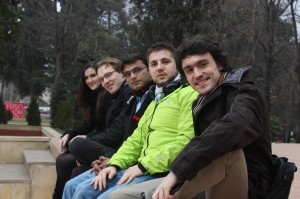 In any conflict there are peace-makers, who co-operate together to create a change agency for the societies. Such people arrived to Baku this time, students from Israel and Palestine who brought the idea of common co-existence in their NGO “YbY” to life, shown the presentation of the Israel – Palestine conflict. They did not agree with each other on everything but they have shown how open-minded people are able to understand each other and actively change friends, families and neighborhood attitudes. If each society gets to learn about their neighbors, their dreams, hopes and fears – people will become aware of the humanity of the other side.
In any conflict there are peace-makers, who co-operate together to create a change agency for the societies. Such people arrived to Baku this time, students from Israel and Palestine who brought the idea of common co-existence in their NGO “YbY” to life, shown the presentation of the Israel – Palestine conflict. They did not agree with each other on everything but they have shown how open-minded people are able to understand each other and actively change friends, families and neighborhood attitudes. If each society gets to learn about their neighbors, their dreams, hopes and fears – people will become aware of the humanity of the other side.
Written by Nikolai Kazantsev, AEGEE-Moscow and Alin-Florin Calin, AEGEE-Europe Liaison Office.


